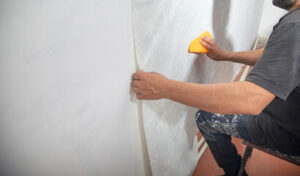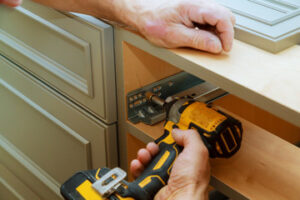Nashville Wallpaper Installers use precision, craftsmanship, and attention to detail to ensure flawless applications. They can transform walls into beautiful works of art that reflect a client’s aesthetic vision.

Experienced installers have access to a wider range of design options and materials. They also know how to measure accurately and cut precisely, minimizing waste.
Wallpaper is an increasingly popular option for homeowners who want to add style and personality to their homes. It’s a cost-effective and durable way to transform a room, and it complements many other materials, including paint and hard furnishings. But hanging wallpaper can be a challenge for people without experience. Hiring a professional can help ensure that the job is done correctly and looks stunning.
Wallpaper installers are skilled professionals with years of experience in the trade. They know how to prepare a surface for application, accurately measure walls, and choose the correct materials to avoid costly mistakes. They also understand the importance of matching patterns and ensuring that seams line up seamlessly. In addition, they can remove existing wallpaper safely and without damaging the wall.
In addition, wallpaper installers are familiar with the complexities of working with high-end or exotic papers and can offer expert advice on how to select the right paper for any space. They can also recommend the best way to hang a particular type of wallpaper or pattern. They can also make recommendations on how to maintain and care for the wallpaper once it’s installed.
Professional wallpaper installers are able to work with any size or scale of pattern, and can use their expertise to make sure that the pattern matches up precisely. They can also work around trim, windows, and doors to create a seamless look. Additionally, they can provide a range of textures and finishes, which will add texture and depth to your space.
Another benefit of hiring a wallpaper installer is their ability to save time and money. They can complete the project quickly and efficiently, avoiding the need for repeat visits and repairs. They can also provide helpful tips and tricks for maintaining your wallpaper, extending its lifespan and keeping it looking fresh.
Hiring a wallpaper installation service is a smart choice for anyone who wants to improve the look of their home or commercial space. But with so many options, it can be difficult to decide which one is right for you. Hiring a professional can help ensure a smooth, flawless installation that will last for years to come.
Safety
Wallpaper installers take a number of safety precautions during the installation process. They follow all manufacturer guidelines and use the proper tools and equipment. They also prepare the walls correctly, which ensures a smooth and professional finish. This may include sanding the wall surface and priming it. They also take care to store and secure their tools properly when they are not in use. They also wear protective gear to avoid any injuries or accidents.
A quality wallpaper hanger should have extensive experience and a good track record of successfully installed wallpaper. A quick online search can reveal customer feedback and testimonials, which are excellent indicators of a contractor’s work quality and professionalism. In addition, a wallpaper hanger should use only eco-friendly products and materials. This will help them reduce the environmental impact of their work and maintain a high level of service.
Another important factor to consider is insurance coverage for wallpaper installers. Liability and workers’ compensation insurance are common options, but it is important to compare costs and coverage limits to find the best option for your business. If you have any questions about the coverage, contact your provider and ask for assistance.
In terms of the installation process, there are a few common issues that can occur during the wallpapering process. These issues include bubbles, wrinkles, and uneven edges. Bubbles and wrinkles can occur if the wallpaper is not stretched tightly when applied to the wall, so a wallpaper smoother or brush can be used to eliminate these problems. Uneven edges can happen if the wallpaper is not cut accurately, so a double-cut technique is recommended to ensure a seamless appearance.
Lastly, it is important to keep in mind that wallpapers are not as permanent as paint and should be removed once the desired look has been achieved. The removal process is more difficult and time-consuming, so it is a good idea to hire a professional to remove the wallpaper for you.
Choosing the right wallpaper for your home can be a difficult decision, but you’ll be glad you made the investment in professional installation. A quality wallpaper will enhance your home’s aesthetic and increase its value. It’s a great way to add texture, color, and dimension to a space, and the results will last for years.
Time
Wallpaper installers have a very important job in the home and commercial building industry. They work with a wide range of materials and designs and have to be able to complete their work quickly, correctly, and with as little disruption to the rest of the project as possible. This is not an easy task for anyone, and it requires a high level of skill and craftsmanship.
Wallpaper can add a sense of depth and dimension to a room, and it is also an excellent way to hide any imperfections in the wall. However, it is important to note that the preparation and installation of wallpaper can take a significant amount of time. In addition, the proper installation of wallpaper can help to protect the walls from damage and stains.
A professional wallpaper installer will ensure that all necessary steps are taken to prepare the surface for the installation. This includes priming the walls and ensuring that all seams are smoothed over. They will also use a special adhesive to ensure that the wallpaper is properly adhered. In addition, a professional will know how to apply wallpaper that is designed for moisture-prone areas such as bathrooms and kitchens.
The professional wallpaper installer will have accounts with various wallpaper suppliers and will be able to get the best prices on the materials needed for the job. This can save the client a lot of money in the long run. In addition, the professional will be able to give the customer advice on what wallpaper is best for their specific decorating scheme.
In some cases, the wallpaper can be ordered in advance and delivered to the job site before the construction schedule has finished. This can save a lot of time and frustration for the new homeowners. The professional wallpaper installer will know how to plan their work and how long it will take to finish the job.
A professional wallpaper installer will have years of experience and a great understanding of how to hang different types of wallpapers. They will be able to work with the designer to create a beautiful and unique space. They will also be able to handle any difficulties that may arise during the process, such as a pattern that doesn’t line up correctly or a seam that is not perfectly straight.
Money
Wallpaper installation is a labor-intensive job that requires specialized tools. Purchasing all of the necessary tools and supplies for the job can quickly add up to an expensive bill. However, hiring professional wallpaper installers is a smart investment that saves money in the long run. The experts use their knowledge to complete the job quickly and efficiently. They can work in tight spaces and on steep staircases, making them ideal for large homes or commercial buildings. They also have access to specialized tools such as wallpaper steamers and scrapers, which make it easier and faster to remove old wallpaper and paint residue.
The experts can also offer advice on design and style. They can help you find the right wallpaper for your space, and they will make sure to measure accurately so that you don’t waste any material. They can also recommend the best adhesive for your wallpaper, which will ensure that it lasts longer and stays intact.
In addition, the experts can provide surface repair and preparation services to guarantee that the walls are ready for the new wallpaper. This prevents cracks and imperfections from marring the appearance of your newly hung wallpaper. It also prolongs the life of your wallpaper, saving you from the cost of frequent repairs or replacements.
While DIY wallpaper installation can be a great way to save money, it can be time-consuming and difficult to get the results you want. It is also not as easy to undo a mistake, so you should carefully consider the location of your wallpaper and how much wall space you will cover.
Professional wallpaper installation is a smart and efficient choice for any home improvement project. It can add instant appeal to your space and increase the value of your home. The professionals can complete the project quickly and efficiently, and they will use quality materials to ensure that the result is flawless. They can also advise on the best types of wallpaper for your home, including vinyl-coated options that are water-resistant and suitable for bathrooms and kitchens. They can also recommend a variety of options, from traditional to modern designs and even natural textile wall coverings.
